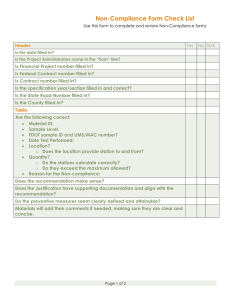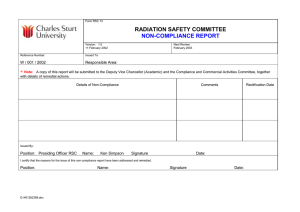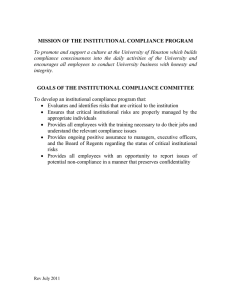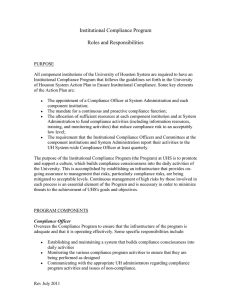Tip Sheet 14: Non-compliance
advertisement
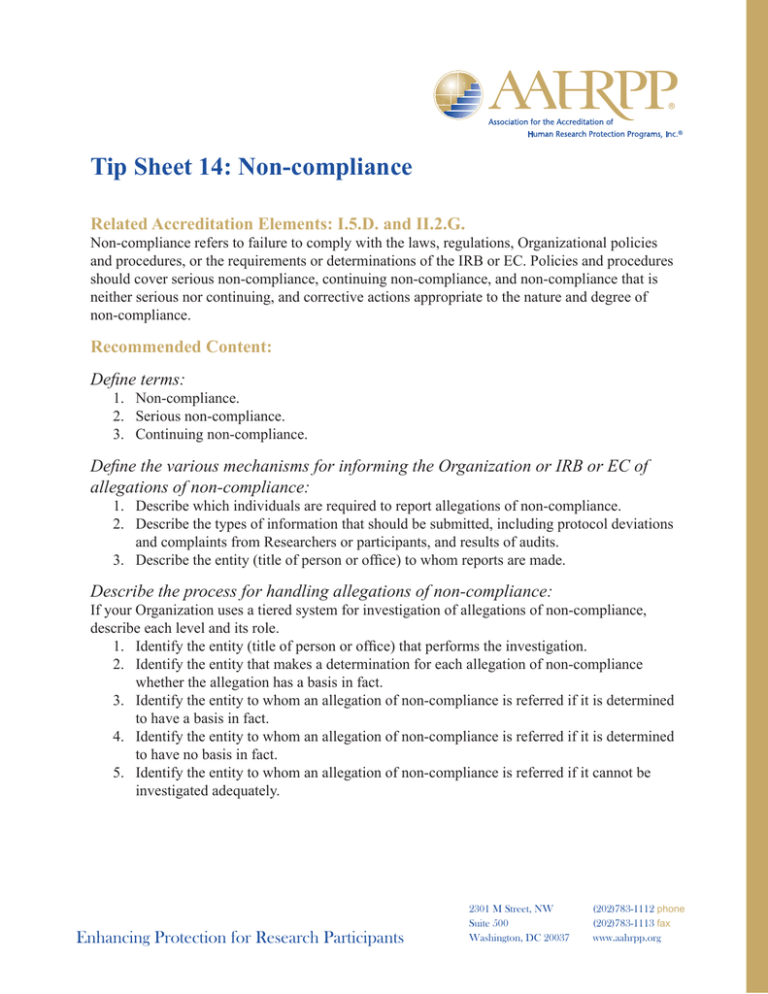
Tip Sheet 14: Non-compliance Related Accreditation Elements: I.5.D. and II.2.G. Non-compliance refers to failure to comply with the laws, regulations, Organizational policies and procedures, or the requirements or determinations of the IRB or EC. Policies and procedures should cover serious non-compliance, continuing non-compliance, and non-compliance that is neither serious nor continuing, and corrective actions appropriate to the nature and degree of non-compliance. Recommended Content: Define terms: 1. Non-compliance. 2. Serious non-compliance. 3. Continuing non-compliance. Define the various mechanisms for informing the Organization or IRB or EC of allegations of non-compliance: 1. Describe which individuals are required to report allegations of non-compliance. 2. Describe the types of information that should be submitted, including protocol deviations and complaints from Researchers or participants, and results of audits. 3. Describe the entity (title of person or office) to whom reports are made. Describe the process for handling allegations of non-compliance: If your Organization uses a tiered system for investigation of allegations of non-compliance, describe each level and its role. 1. Identify the entity (title of person or office) that performs the investigation. 2. Identify the entity that makes a determination for each allegation of non-compliance whether the allegation has a basis in fact. 3. Identify the entity to whom an allegation of non-compliance is referred if it is determined to have a basis in fact. 4. Identify the entity to whom an allegation of non-compliance is referred if it is determined to have no basis in fact. 5. Identify the entity to whom an allegation of non-compliance is referred if it cannot be investigated adequately. Enhancing Protection for Research Participants 2301 M Street, NW Suite 500 Washington, DC 20037 (202)783-1112 phone (202)783-1113 fax www.aahrpp.org Describe the process for handling incidents of non-compliance: 1. Identify the entity that performs the investigation. 2. Identify the entity that makes a determination for each incident of non-compliance whether the non-compliance is serious or continuing. 3. Identify the entity to whom non-compliance is referred if it is determined to be serious or continuing. 4. Identify the entity to whom non-compliance is referred if it is determined to be neither serious nor continuing. Describe the process for handling non-compliance that is determined to be neither serious nor continuing: 1. Describe the process for managing non-compliance determined to be neither serious nor continuing: a. Describe the entity that may handle the non-compliance. b. Describe the types of actions that might be taken. c. Identify the entity to whom the non-compliance is referred if it cannot be handled adequately. d. Describe when the IRB or EC becomes involved. Describe the process for handling serious or continuing non-compliance: 1. Have serious or continuing non-compliance reviewed by the convened IRB or EC. 2. Describe the types of information provided to the IRB or EC for review of serious or continuing non-compliance: a. Describe the specific documents provided to primary reviewers, if a primary reviewer system is used. b. Describe the specific documents provided to all other IRB or EC members. 3. Describe the types of actions the IRB or EC might take: a. Required: i. Suspension of the research (See Tip Sheet – Suspensions and Terminations of IRB or EC Approval). ii. Termination of the research (See Tip Sheet – Suspensions and Terminations of IRB or EC Approval). iii. Notification of current participants (required when such information might relate to participants’ willingness to continue to take part in the research). b. Optional: i. Modification of the research protocol. ii. Modification of the information disclosed during the consent process. iii. Additional information provided to past participants. iv. Notification of current participants (required when such information might relate to participants’ willingness to continue to take part in the research). Enhancing Protection for Research Participants 2301 M Street, NW Suite 500 Washington, DC 20037 (202)783-1112 phone (202)783-1113 fax www.aahrpp.org v. Requirement that current participants re-consent to participation. vi. Modification of the continuing review schedule. vii.Monitoring of the research. viii.Monitoring of the consent. ix. Obtaining more information pending a final decision. x. Referral to other Organizational entities (e.g., legal counsel, risk management, institutional official). xi. Other actions appropriate for the local context. 4. Describe the process used to report serious or continuing non-compliance. (See Tip Sheet – Reporting Unanticipated Problems Involving Risks to Participants or Others, Termintations or Suspensions of IRB or EC Approval, and Serious or Continuing NonCompliance) Enhancing Protection for Research Participants 2301 M Street, NW Suite 500 Washington, DC 20037 (202)783-1112 phone (202)783-1113 fax www.aahrpp.org
